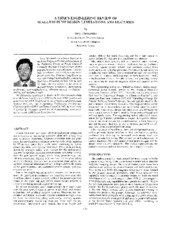| dc.description.abstract | Exxon Chemical like many other petrochemical companies and refineries, is announcing emission plans with a long term goal to achieve continuous emission reduction from the plant sites. Exxon Chemical’s emission plan has reduced air emission by 90 percent since 1975, with work continuing to further reduce emissions over the next five years. These foals are being driven by company policy with concern for the environment, business competition, government regulations, and public concern over the past several years. Since many petrochemical and refinery employees, friends, and relatives live in areas where plants are located, they are just as concerned about safety and hygiene impact of emissions and waste disposal from the plants as the general public, environmental activist groups, and government agencies. Due to the steadily increasing public concern over the environment, the government regulations are becoming more restrictive in leakage criteria. A good example of this is the current regulatory debate to the Clean Air Act, which would require industry to utilize maximum achievable control technology. To reduce emissions, great improvements have been made over the past several years in pump mechanical seal design, evaluation, and auxiliary support systems. However, the mechanical seal design inherently requires a minute leakage across the faces for lubrication, along with costly auxiliary systems and environmental monitoring programs. Even with the improvements, mechanical seals remain the most fragile and weakest link of the pump; thus, they are the primary cause of pump failures [1] that can also contribute to emissions. Mechanical seals typically fail as a result as a result of many factors, such as process upsets, vibration problems, bearing failures, auxiliary support system failures, and problems caused from maintenance and operating personnel. Consequently, one solution to reducing pump failures due to mechanical seals and resulting emissions is to apply sealless pumps to more hazardous, toxic, or hydrocarbon services. For this reason, an engineering survey was launched to evaluate magnetic drive and canned motor pumps.. | en |


